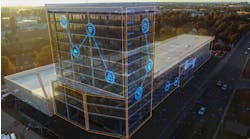How to maximize the value of IoT sensors and devices—without annoying IT personnel
When selecting and integrating IoT sensors or devices into a building, owners and their installers and operators must consider the type of data that will be collected, how it is collected, and how it will be fed into the overall building platform.
IoT devices, sensors, and their gateways cross over between operational technology (OT) and information technology (IT). The technologies, which might monitor indoor air quality (IAQ) or provide occupancy and usage information, do not act like typical IT hardware devices that IT personnel are used to managing, such as switches and routers. However, once IoT devices are installed, IT managers often become responsible for their ongoing operation and maintenance because they live on the IT network.
Below are seven questions that systems integrators and IT managers should ask a manufacturer or IoT device expert and consultant about an IoT sensor:
1. What version of TLS security does the IoT sensor, device, or gateway support?
Encryption is key as data moves from the device to a server or the cloud. Transport layer security (TLS) is the security protocol designed to encrypt and protect traffic between client and server. Ensuring that a device supports the latest version of TLS is critical for network security.
2. Does the IoT sensor, device, or gateway support the NTP protocol?
Network time protocol (NTP) is used to synchronize time to a reference source. As the device comes onto a network, it needs to be synced to the same time as other devices on the network. This is particularly important for mining historical sensor data and authentication with security certificates.
3. Does the IoT sensor, device or gateway support the Domain Name System (DNS)?
Once the IoT sensor or device enters the network, the network will give it a human-readable name so it can be discoverable. DNS allows the use of common URL names like microsoft.com rather than http://134.56.781, and it makes maintaining and operating these devices more manageable for IT teams.
4. Does the IoT sensor support Dynamic Host Configuration Protocol (DHCP)?
DHCP will dynamically assign an IP address to the device, which should be able to pick up that IP address and take its place as a manageable device on the network. When a building contains hundreds or thousands of sensors to manage, the devices should be able to power up and receive an IP address without physical human involvement. Instead of creating devices without DHCP, many manufacturers will rely on IT managers to manually connect and assign an available IP address from their pool. This creates ongoing headaches for IT managers should these devices experience a power failure event—which would knock out device configurations—and when they install regular firmware and security updates.
5. Does the IoT device have a second IP port? Can it be disabled?
Some devices have a second IP port to ease management of device configurations and setup. Corporate IT entities generally shun these types of ports, which provide root access to the device, as they are another vector for attack or security threat. The software running on the device or different hardware configurations should allow for IT managers to shut off access to these ports completely.
6. What data is captured, stored, and processed by IoT sensors or devices?
IoT sensors or devices may include cameras to capture video and images for data processing, analytics, and reports. But where and how will this data be stored, and how will it be destroyed after post-processing? Some companies must adhere to industry and internal regulations on the collection and storage of images, which might contain sensitive information that can expose trade secrets or identify people and assets. Corporate IT will commonly establish policies that will govern the use and storage of such data. HR might also become involved particularly if the data involves personally identifiable information or employee tracking. Many organizations have multiple departmental data security policies, and IoT sensors, devices, and gateways must fit as these policies evolve.
7. Does the IoT sensor scale to other regions?
Owners may need IoT sensors to support IAQ and energy monitoring applications across a portfolio of buildings in multiple, regional locations. To scale a project, system integrators should consider logistical challenges to acquiring, installing, and supporting the equipment. Some sensors may be available in one country or region, but not in others. Prior to purchasing a product, system integrators should check with the manufacturer to see if it can support their client’s unique regional needs.
Communication protocols and the cloud
For data to be captured, transmitted, and stored correctly, systems integrators need to check the communication protocols of each manufacturer’s sensor type to the cloud.
IoT devices might send data to the cloud using MQTT, an agnostic standard protocol for devices to publish messages. However, the sensor manufacturer might backhaul the data collected by the sensor to a cloud solution to conduct post-processing on the data. After the information has been post-processed, the manufacturer might add value or enrich the data in some way. In many cases, it will charge a monthly or yearly fee to access an owner’s “enriched” data.
This can complicate matters because to access the data, integrators will need to buy another service that uses the manufacturers’ API. Some building managers have preferences for cloud services, or their IT department might grant approval for data to reside on Amazon Web Services, Google Cloud Platform, Azure, Oracle, IBM, or another cloud system, which will require further configuration.
How to evaluate IoT sensors
When we integrate a new sensor type from a new sensor manufacturer, we first evaluate the quality of the sensor. We might consult a hardware specialist to determine the sensor’s operational longevity or power needs and sources.
Next, we look at the APIs, communication protocols or requirements, and the feasibility of collecting and integrating the necessary data with the building’s existing devices. Finally, we build the actual software components to help integrate that sensor into a building management system or platform.
How to integrate sensors into building systems
IoT sensors should not be siloed. The true value of their investment lies in their ability to integrate into the holistic building system and collect data for insights. Building managers and owners want to see air quality data and HVAC equipment performance on a single screen or in a consolidated data repository. Flipping between one system and the other is not ideal.
Whether the IoT sensors can be integrated and are interoperable matters. If a good API is available and supplied with the devices, cloud integration with data from other building systems will be easier.
Straight communication—not wanting to have a project’s sensor data hosted by another vendor or cloud provider—is another option. Building operators or integrators can work directly with a commonly accepted, secure messaging protocol, like MQTT.
Information from an IoT sensor needs to be understood, so the devices must be configured to ensure the messages come in a standardized way. If dozens of sensors are deployed across a building portfolio, they should speak the same way. With the volume of incoming data they generate, someone also needs to manage and understand the data.
Over the long term, degradability in overall performance, including the accuracy of readings and data quality, might arise. Monitoring the IoT sensors to ensure their data collection ability remains reliable is critical; this responsibility would fall to IT, the system integrator, or whoever is identified as overseeing sensor maintenance over the device’s life cycle. This individual or team should also perform regular firmware upgrades or consider fleet management software to monitor and upgrade the IoT sensors.




